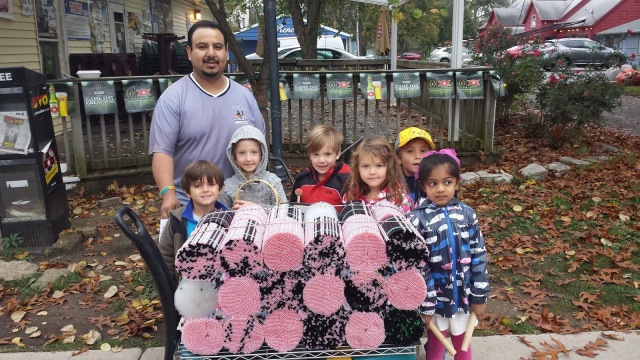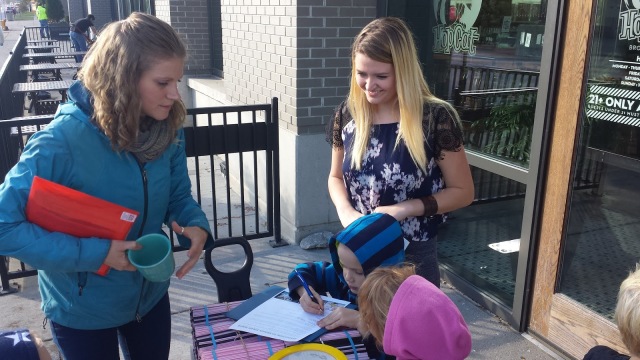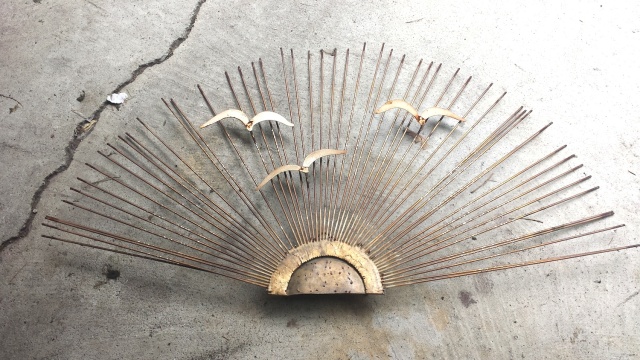This post is republished with permission from author Jim Poyser and Earth Charter Indiana. The original article can be found here.
I remember the moment the image came to mind, and it gave me a good laugh. I was in a restaurant somewhere in Indianapolis, and as I scanned the people and tables surrounding me, I saw a sea of straws sticking out of glasses. Some folks even had two straws, one in their water, one in their soda. I knew there was a high possibility that this sea of straws would end up somewhere in our eco system — even conceivably in the sea itself — poisoning our water and soil and being ingested by living creatures.
And so it was in a flash I thought of collecting these reprehensible straws and assembling them into a straw bale.
Call it a labor not of love, but of hate.
At the time, it was a fun visual pun; I had no idea I would actually do it, nor that it would turn into a project that YOU can do. Now that my #Strawbale is finished, my disgust for straws has turned to action, and you can take action yourself, by following the steps below — or adapting them to your own needs. Note I am working with 3-6 year olds (see below) and with high school students on the decal to thank restaurants who change their straw culture, so you can see it’s a project that can be scaled to any age group.
First though, let me thank the daVinci Pursuit, for giving me the opportunity to actually create this #Strawbale. If they weren’t doing a project on plastic waste in our waterways, I would not have been inspired to follow through and manifest this visual pun idea into something real. Thanks also to Neal Brown and Pizzology, who collected the majority of the straws for the first #Strawbale. And finally, to Nate Garvey, an artist and friend, who helped me conceive of how to do the second #Strawbale in such a way as to eliminate the majority of any toxic adhesives to hold the bale together.
Step One: Do the Research
What happens to straws after use in restaurants? Why is plastic waste bad for the environment? Where does plastic waste end up? You can do your own inquiry project with this, but it’s important your students or troop or group find their own answers, and utilize resources like Eco-Cycle. For those who have not found the plastic “islands” that swirl around our oceans, the discovery will be a revelation.
Also, if you can, include a calculation of the oil used and carbon emissions burned in the production and delivery of straws.
Step Two: Collect the Straws
I have now done two #Strawbales, the first completed early in 2016, the other in September. The first one is quite ugly, while the second, if I do say so myself, has a certain aesthetic charm.
For both #Strawbales I sent out queries to restaurants where I had a personal connection: a server, chef, manager, owner, etc. Most restaurants I contacted were immediately supportive. They don’t like straws either! Straws cost money and make a mess for waitstaff to clean up. I tried to be as carbon neutral as possible in collecting the straws, using my bike or the bus. If I did have to drive, I made sure I hit up as many restaurants as possible at once to reduce the number of car trips.
For the second #Strawbale I teamed up with a neighborhood association, Broad Ripple Village Association. Executive Director Brooke Klejnot was incredibly helpful, gathering together a number of Broad Ripple restaurants for a meeting on this project. The restaurants, in turn, were incredibly helpful and collected straws for me.
 |
| Each week or so I would collect straws from participating restaurants. |
Participating Broad Ripple restaurants: 10-01, Bazbeaux, Brics, Corner Wine Bar, HopCat, La Piedad, Northside Kitchenette, Thr3e Wise Men, Union Jack Pub.
Step Three: Wash the Straws
That’s right! These little buggers are gross! There’s lipstick on them, and they are nervously chewed, and who knows what germs are on them. You can wash by hand like I did (not recommended if you have high blood pressure), or utilize an industrial sink at your school or at one of the participating restaurants. Someone suggested I put them in a dishwasher, but I never tried that.
 |
| I repurposed rainwater captured by my rain barrel to wash the straws. |
Step Four: Assemble the Straws into a Straw bale
The first #Strawbale was assembled by “gluing” blocks of straws together with a spray adhesive, then attaching the blocks together with the adhesive until the shape was completed. It was effective but used a lot of spray cans, and overall felt like the wrong, antithetical, approach.
The second #Strawbale, thanks to Nate’s creative ideas, used only a small bit of adhesive. Nate landed upon the idea of using a coffee can to cram the straws into to create little round mini-bales.
 |
|
|
 |
| Ready to thread the metal rods through two to three mini bales at a time. |
 |
| Nate Garvey’s artist’s rendering of #Strawbale 2. |
Next we placed metal rods into the mini-bales to connect them together. I found some metal rod material just sitting around in my garage. I ended up using a wee bit (less than one can) of spray adhesive to bond just a few of the inner bales together since the rods didn’t seem strong enough.
Step Five: Filling the Gaps Creates an Opportunity for Assistance
Nate and I did these steps above on our own, but you can include students and young people all along the way. But if you are at the stage where you want to bring help in, what I did was reach out to Broad Ripple Village Montessori, a non-sectarian private school for 3-6 year olds. I met with the kids who then began collecting their straws from local restaurants. We held an inquiry discussion about straws and plastic waste, then the youth filled the gaps in the straw bale, completing it.
They also estimated the number of straws at between 9000 and 10,000.
 |
| Village Montessori kids collected these straws to use in the #Strawbale, increasing their sense of ownership. |
 |
| Filling in the gaps — and estimating the number of straws — in #Strawbale. |
Of course, you can involve students from the very beginning.
Step Six: Cordage
To make your #Strawbale look legit AND to create a structural enhancement, you’ll need to band it with some kind of cordage. You could use string or cord if you’d like. We considered using natural materials thanks to instruction from our friends at White Pine Wilderness Academy. But then we landed upon the idea of using discarded plastic bags, to further advance the idea of reducing plastic waste. Here’s one video instruction on reverse twist for cordage, but by all means hunt for your own resources.
 |
| Here, William uses a chair to anchor his reverse twist method. |
Step Seven: Go Public!
Well, your whole process up to now can be “public” in that you are taking photos and posting to social media. But for us, once we got the #Strawbale done, we decided to have a parade in Broad Ripple, to show off the #Strawbale, to hand out hand written thank you notes, and to spread the Strawbale Resolution (see below).
But there are lots of ways to make it public: your #Strawbale could be in your school’s art fair, or your community center’s sustainability exhibit. But I gotta say, parades are fun!
 |
| Each Village Montessori student had a drum or tambourine. |
 |
| A lot of our straws came from La Piedad. After giving them our thank you card, we posed for this picture above and below. |
Step Eight: The Resolution
That’s right, it’s not enough to spread awareness about plastic straw waste, you have to get a commitment by restaurants. Now, we here at Earth Charter Indiana are not in the business of banning things, it just doesn’t work here in Indiana. So our Resolution simply says “We will not hand out straws unless a customer asks for one.” Simple as that!
 |
| There is a line on the Resolution where a “witness” can sing. In this instance one of the students signed his name after HopCat manager signed hers. It was a solemn, inspiring ceremony. |
You can use our resolution if you’d like! Email me at jimpoyser@earthcharterindiana.org.
Step Nine: Celebrate!
You did it! Make sure you find a way to celebrate progress. Our next step is design a decal for participating restaurants to place on their windows. Students from Park Tudor High School are creating the “Low Straw Zone” images. Stay tuned for more!



